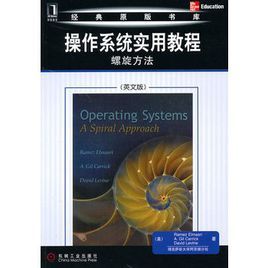內容簡介
 作業系統實用教程:螺旋方法
作業系統實用教程:螺旋方法本書分為六個部分:第一部分介紹一些總體背景信息;第二部分採用螺旋方法,按照複雜度遞增的次序,介紹五類作業系統;第三部分到第五部分採用深度導向方法詳細地探討作業系統的各個主題:從進程到記憶體管理,再到檔案系統;第六部分通過三個實例更深入地研究這些系統的特性是如何實現的。
本書特色
·對於所討論的作業系統,書中適當介紹一些當時的行業歷史,有時還涉及關鍵的企業或個人,這樣能幫助學生更好地理解作業系統。
·涵蓋在設備中的現代作業系統,而不僅僅是通常的計算機中的作業系統。
·討論算法級解決方案,而沒有列出實際代碼,便於使用不同程式語言實現。
·每章末都有一些練習題,便於學生鞏固所學知識。
作者簡介
Ramez Elmasri,德克薩斯大學阿靈頓分校教授。他於1980年在美國史丹福大學獲得計算機科學碩士和博士學位。其研究興趣是感測器網路和RFID、生物信息介質、查詢個性化和系統集成。
圖書目錄
Preface viii
Part 1 Operating Systems Overview and Background
Chapter 1 Getting Started
Chapter 2 Operating System Concepts, Components,and Architectures
Part 2 Building Operating Systems Incrementally: A Breadth-Oriented Spiral Approach
Chapter 3 A Simple, Single-Process Operating System
Chapter 4 A Single-User Multitasking Operating System
Chapter 5 A Single-User Multitasking/Multithreading Operating System
Chapter 6 A Multiple-User Operating System
Chapter 7 Parallel and Distributed Computing, Clusters,and Grids
Part 3 CPU and Memory Management
Chapter 8 Process Management: Concepts, Threads,and Scheduling
Chapter 9 More Process Management: Interprocess Communication, Synchronization,and Deadlocks
Chapter 10 Basic Memory Management
Chapter 11 Advanced Memory Management
Part 4 A Depth-Oriented Presentation of OS Concepts: Files Systems and Input/Output
Chapter 12 File Systems-Basics
Chapter 13 File Systems-Examples and More Features
Chapter 14 Disk Scheduling and Input/Output Management
Part 5 Networks, Distributed Systems,and Security
Chapter 15 Introduction to Computer Networks
Chapter 16 Protection and Security
Chapter 17 Distributed Operating Systems
Part 6 Case Studies
Chapter 18 Windows NT through Vista
Chapter 19 Linux: A Case Study 445
Chapter 20 Palm OS: A Class Case Study
Appendix Overview of Computer System and Architecture Concepts
